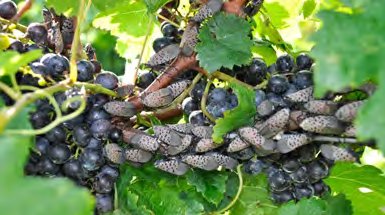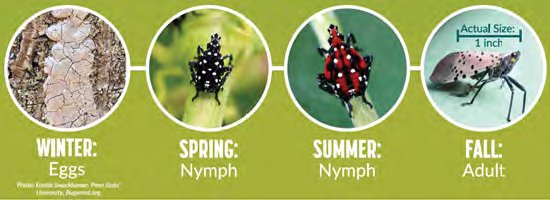AgEBB-MU CAFNR Extension
Green Horizons
Volume 25, Number 3
Fall 2021
 |
| Cole Kiczenski surveying a stand of tree-of-heaven looking for the invasive spotted lanternfly. Photo credit: Sarah Phipps |
Roadway to the Tree-of-Heaven: Surveying for the Invasive Spotted Lanternfly
Sarah Phipps, Missouri Department of Agriculture
Scanning the roadways, fencerows, wood margins and vacant lots - Missouri Department of Agriculture, Plant Pest Control team members are on the look-out for the invasive tree-of-heaven (Ailanthus altissima). Tree-of-heaven is a fast-growing tree that can average three feet of height growth per year. It can easily take over large tracts of disturbed land due to its clonal nature of sending up root suckers as far as 50 feet from the parent tree.
The tree-of-heaven is a favored host to a pesky insect that is on our radar- the spotted lanternfly!
The spotted lanternfly (Lycorma delicatula) is a large planthopper native to Asia. Its appetite is not limited solely to the tree-of-heaven though. It feeds on the sap of more than 70 plant species, including grape, apple, hops, oak, walnut, maple and ornamental plants. This bad bug has the potential to damage our forests and food supply by feeding on trees and crops. If allowed to spread, the pest could seriously impact the nation's grape, orchard and logging industries.
 |
| Spotted lanternfly feeding on grapevines. Photo credit: Erica Smyers, Penn State |
 |
| Watercolor painting of spotted lanterfly, 2019 Credit: Carrie Garrott |
Spotted lanternfly was first detected in the United States in Pennsylvania in 2014 and is suspected to have hitchhiked there on stone slab shipments from South Korea. Additional detections have been reported in a growing list of states, with the most recent find in Indiana. New infestations are being found hundreds of miles away from the next nearest known infestation, indicating that the pest is hitchhiking with humans. They lay their egg masses on any hard, smooth surface, including firewood, landscape materials, outdoor furniture, vehicles and more. Fortunately, we haven't found any spotted lanternfly populations in Missouri, but the MDA Plant Pest Control team remains on the look-out for this pest!
Lifecycle Description:
Spotted lanternflies go through five stages of growth after hatching from eggs. The first four stages are called nymphs. The tiny nymphs are initially black with white spots, but eventually develop red areas on their bodies. Adults are about an inch long, are gray and black, and have hind wings with bright red patches. Adult spotted lanternflies are present from July through December. Egg masses of 30-50 eggs overwinter and hatch in the spring.
 |
How can you help?
Early detection is key. Inspect your trees and plants for signs of this pest, particularly at dusk and at night when the insects tend to gather in large groups on the trunks or stems of plants. Inspect trees (in particular, tree of heaven), bricks, stone or other smooth surfaces for egg masses. If you think you have found spotted lanternfly, follow these steps:
 |
Additional Resources:
Spotted Lanternfly Brochure and Poster: https://agriculture.mo.gov/plants/pests/spotted-lanternfly-brochure.pdf
USDA Hungry Pest Website https://www.aphis.usda.gov/aphis/resources/pests-diseases/hungry-pests/slf/spotted-lanternfly
Penn State Tree of Heaven Website https://extension.psu.edu/tree-of-heaven
